NASA’s Orion spacecraft is built to take humans farther than they’ve ever gone before. Orion will carry the crew to space, provide emergency abort capability, sustain the crew during the space travel, and return them safely to earth.
Don't wanna be here? Send us removal request.
Text
How to Use Data From NASA’s AROW Tweets
Follow NASA’s Orion spacecraft on its first mission around the Moon with the Artemis Real-time Orbit Website (AROW). AROW visualizes data collected by sensors on Orion and provides periodic real-time data during NASA’s Artemis I mission. AROW is available on NASA’s website and on the @NASA_Orion Twitter account.
AROW will periodically tweet a set of Orion’s state vectors — data that describes precisely where Orion is located in space and how it moves — from Orion’s official twitter account once Orion is flying on its own.
You can use the information shared in AROW Twitter updates, explained below, to create a physics model, animation, visualization, tracking app, or anything imaginable. Here are some ideas for getting started:
Use the fundamental statistics to track or graph Orion’s distance from Earth or the Moon; its total distance traveled, closest lunar approach, farthest distance from Earth, etc.
Use the applied statistics to track or graph Orion’s acceleration due to gravity at a given time, using the position of Earth and Moon or comparing Orion's trajectory to the Apollo missions.
Create an animation or visualization of the mission to scale — maybe a time-lapsed view from inside the crew module looking out the window.
Based on data, recreate the mission in a space flight simulation video game platform with realistic orbits and maneuvers.
The data shared in AROW tweets are Orion’s state vectors, defined within the Earth-centered inertial coordinate frame J2000.
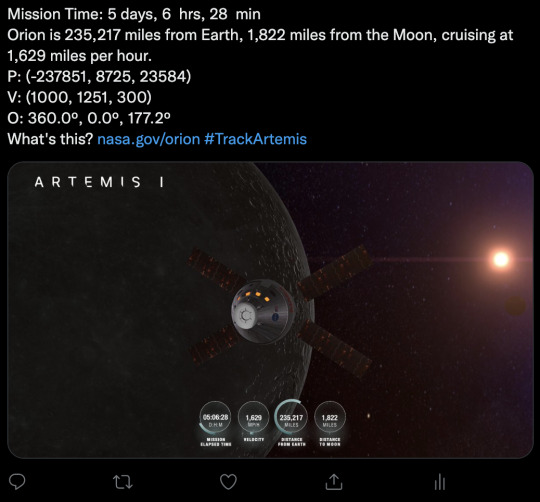
The P (position) coordinates provided represent Orion’s location on three planes:
Position (miles):
x=-237851, y=8725, z=23584
The x–y plane matches the equatorial plane of Earth.
The x-axis is permanently fixed in a direction relative to the celestial sphere, which does not rotate as Earth does.
The z-axis lies at a 90° angle to the equatorial plane and extends through the North Pole.
The y-axis is found by rotating the x-axis by 90° east around the z-axis.
To find a value for Orion’s distance from Earth, the Pythagorean theorem () can be used.
The three V (velocity) vectors represent Orion’s rate of change, corresponding with the position coordinates above:
Velocity (miles/hour):
x=1000, y=1251, z=300
As with position, the Pythagorean theorem can be used to find a value for Orion’s speed.
Also provided are O (orientation) vectors that describe the way Orion is pointing:
Orientation:
x=360.0°, y=0.0°, z=177.2°
Orion’s orientation is represented as three rotations measured in degrees around each of the axes laid out above.
Follow @NASA_Orion on Twitter for AROW mission updates during Artemis I, the first integrated test of the Orion spacecraft, Space Launch System (SLS) rocket and the ground systems at Kennedy Space Center in Cape Canaveral, Florida. Through Artemis missions, NASA will land the first woman and the first person of color on the surface of the Moon, paving the way for a long-term lunar presence and serving as a steppingstone on the way to Mars.
Find more information about state vectors at:
https://www.nasa.gov/pdf/466741main_AP_ST_Calc_ShuttleGNC.pdf
Track Orion during Artemis I at:
https://www.nasa.gov/specials/trackartemis/
46 notes
·
View notes
Text
Follow Orion Creatively During NASA’s Artemis I Mission

Trajectory data from the Orion spacecraft’s first mission around the Moon will be available to the public through NASA’s Artemis Real-time Orbit Website, also known as AROW. AROW, available on NASA’s website and on the @NASA_Orion Twitter account, allows almost anyone with internet access to track Orion’s flight as it happens.
Orion will travel to the Moon and 40,000 miles beyond on Artemis I, its first integrated flight test with the Space Launch System (SLS) rocket. Users can download trajectory data from the flight, called an ephemeris, from the AROW web page.
The ephemeris data can be used to track Orion with your own spaceflight software application or telescope. It can also be used to create a physics model, animation, visualization, tracking application, or other conceivable projects.
This data is generated by the Flight Dynamics Operations (FDO) group in the Mission Control Center at NASA’s Johnson Space Center in Houston. FDO is responsible for trajectory operations of Orion, keeping track of where the spacecraft is and where it is going to be. FDO uses tracking data from the Deep Space Network and predictive models to constantly update Orion’s predicted trajectory, so the Artemis flight control team has the best trajectory estimate possible. An accurate trajectory is essential for achieving mission objectives, maintaining communications links, lighting, adjusting the trajectory, and more.
Links at the bottom of the AROW web article will have the most current posted ephemeris. The ephemeris is in the Consultive Committee for Space Data Systems (CCSDS) Orbital Ephemeris Message (OEM) standard — a text file containing a header, metadata, explanatory information, and ephemeris data, available in the .txt file format.
After the OEM header, Orion state vectors — data describing exactly where Orion is located in space, and how it is moving — in the Mean of J2000 (J2K) reference frame are listed at four-minute intervals until entry interface at the end of mission. During trajectory maneuvers, the state vectors are reported in two-second intervals. Each state vector lists the time in Coordinated Universal Time (UTC); position X, Y, and Z in km; and velocity X, Y, and Z in km/s.
OEMs will be publicly available after Orion separates from the SLS rocket’s interim cryogenic propulsion stage that will give the spacecraft the big in-space push needed to fly beyond the Moon. Entry data will also be available for Orion’s return to Earth.
Follow @NASA_Orion on Twitter for AROW mission updates during Artemis I. Through Artemis missions, NASA will land the first woman and the first person of color on the surface of the Moon, paving the way for a long-term lunar presence and serving as a steppingstone on the way to Mars.
Track Orion during Artemis I at:
https://www.nasa.gov/specials/trackartemis/
View the latest ephemeris at:
https://www.nasa.gov/feature/track-nasa-s-artemis-i-mission-in-real-time
Erika Peters
NASA’s Johnson Space Center
64 notes
·
View notes
Text
The Big Build: Artemis I Stacks Up
Our Space Launch System (SLS) rocket is coming together at the agency’s Kennedy Space Center in Florida this summer. Our mighty SLS rocket is set to power the Artemis I mission to send our Orion spacecraft around the Moon. But, before it heads to the Moon, NASA puts it together right here on Earth.
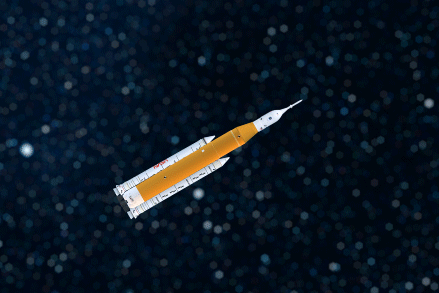
Read on for more on how our Moon rocket for Artemis I will come together this summer:
Get the Base
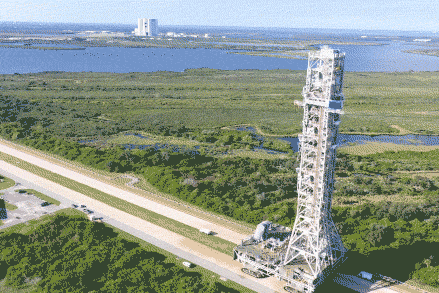
How do crews assemble a rocket and spacecraft as tall as a skyscraper? The process all starts inside the iconic Vehicle Assembly Building at Kennedy with the mobile launcher. Recognized as a Florida Space Coast landmark, the Vehicle Assembly Building, or VAB, houses special cranes, lifts, and equipment to move and connect the spaceflight hardware together. Orion and all five of the major parts of the Artemis I rocket are already at Kennedy in preparation for launch. Inside the VAB, teams carefully stack and connect the elements to the mobile launcher, which serves as a platform for assembly and, later, for fueling and launching the rocket.
Start with the boosters
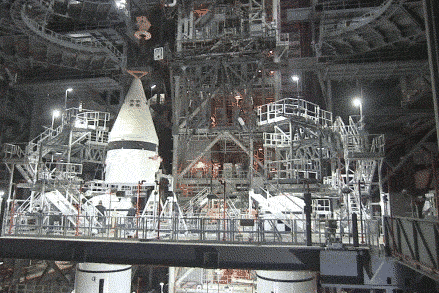
Because they carry the entire weight of the rocket and spacecraft, the twin solid rocket boosters for our SLS rocket are the first elements to be stacked on the mobile launcher inside the VAB. Crews with NASA’s Exploration Ground Systems and contractor Jacobs team completed stacking the boosters in March. Each taller than the Statue of Liberty and adorned with the iconic NASA “worm” logo, the five-segment boosters flank either side of the rocket’s core stage and upper stage. At launch, each booster produces more than 3.6 million pounds of thrust in just two minutes to quickly lift the rocket and spacecraft off the pad and to space.
Bring in the core stage

In between the twin solid rocket boosters is the core stage. The stage has two huge liquid propellant tanks, computers that control the rocket’s flight, and four RS-25 engines. Weighing more than 188,000 pounds without fuel and standing 212 feet, the core stage is the largest element of the SLS rocket. To place the core stage in between the two boosters, teams will use a heavy-lift crane to raise and lower the stage into place on the mobile launcher.
On launch day, the core stage’s RS-25 engines produce more than 2 million pounds of thrust and ignite just before the boosters. Together, the boosters and engines produce 8.8 million pounds of thrust to send the SLS and Orion into orbit.
Add the Launch Vehicle Stage Adapter
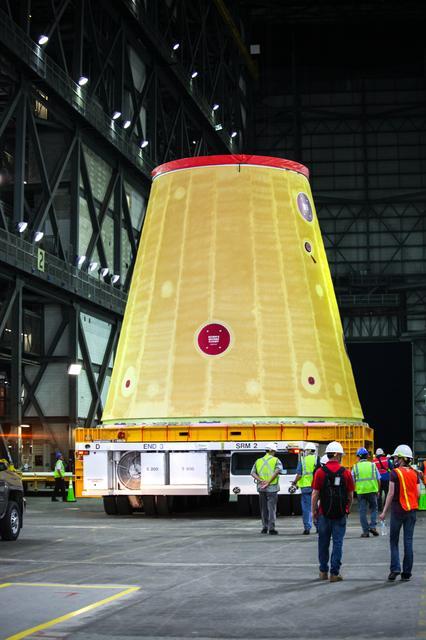
Once the boosters and core stage are secured, teams add the launch vehicle stage adapter, or LVSA, to the stack. The LVSA is a cone-shaped element that connects the rocket’s core stage and Interim Cryogenic Propulsion Stage (ICPS), or upper stage. The roughly 30-foot LVSA houses and protects the RL10 engine that powers the ICPS. Once teams bolt the LVSA into place on top of the rocket, the diameter of SLS will officially change from a wide base to a more narrow point — much like a change in the shape of a pencil from eraser to point.
Lower the Interim Cryogenic Propulsion Stage into place
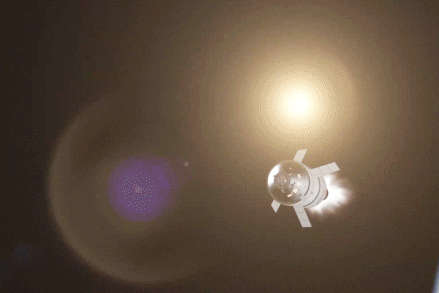
Next in the stacking line-up is the Interim Cryogenic Propulsion Stage or ICPS. Like the LVSA, crews will lift and bolt the ICPS into place. To help power our deep space missions and goals, our SLS rocket delivers propulsion in phases. At liftoff, the core stage and solid rocket boosters will propel Artemis I off the launch pad. Once in orbit, the ICPS and its single RL10 engine will provide nearly 25,000 pounds of thrust to send our Orion spacecraft on a precise trajectory to the Moon.
Nearly there with the Orion stage adapter
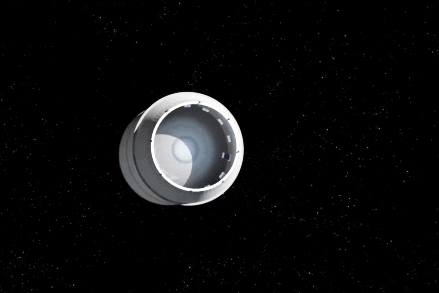
When the Orion stage adapter crowns the top of the ICPS, you’ll know we’re nearly complete with stacking SLS rocket for Artemis I. The Orion Stage Adapter is more than just a connection point. At five feet in height, the Orion stage adapter may be small, but it holds and carries several small satellites called CubeSats. After Orion separates from the SLS rocket and heads to the Moon, these shoebox-sized payloads are released into space for their own missions to conduct science and technology research vital to deep space exploration. Compared to the rest of the rocket and spacecraft, the Orion stage adapter is the smallest SLS component that’s stacked for Artemis I.
Top it off

Finally, our Orion spacecraft will be placed on top of our Moon rocket inside the VAB. The final piece will be easy to spot as teams recently added the bright red NASA “worm” logotype to the outside of the spacecraft. The Orion spacecraft is much more than just a capsule built to carry crew. It has a launch abort system, which will carry the crew to safety in case of an emergency, and a service module developed by the European Space Agency that will power and propel the spacecraft during its three-week mission. On the uncrewed Artemis I mission, Orion will check out the spacecraft’s critical systems, including navigation, communications systems, and the heat shield needed to support astronauts who will fly on Artemis II and beyond.
Ready for launch!
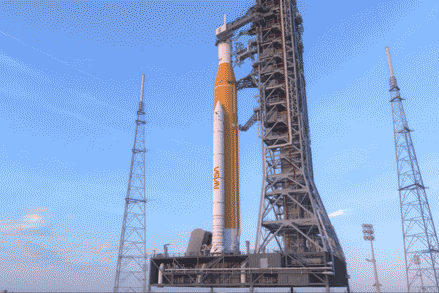
The path to the pad requires many steps and check lists. Before Artemis I rolls to the launch pad, teams will finalize outfitting and other important assembly work inside the VAB. Once assembled, the integrated SLS rocket and Orion will undergo several final tests and checkouts in the VAB and on the launch pad before it’s readied for launch.
The Artemis I mission is the first in a series of increasingly complex missions that will pave the way for landing the first woman and the first person of color on the Moon. The Space Launch System is the only rocket that can send NASA astronauts aboard NASA’s Orion spacecraft and supplies to the Moon in a single mission.
Make sure to follow us on Tumblr for your regular dose of space!
1K notes
·
View notes
Video
tumblr
May The 4th Be With You! Happy Star Wars Day from NASA's Artemis X-Wing team!
105 notes
·
View notes
Photo

Orion will skip to a smoother, more accurate splashdown on Artemis I. Read about it here: https://www.nasa.gov/feature/orion-spacecraft-to-test-new-entry-technique-on-artemis-i-mission
82 notes
·
View notes
Photo

Want to watch me make a big splash? Tuesday we will doing a water drop test NASA Langley Recearch Center's gantry. This is the second of four tests, which are aimed to help our team prepare for Artemis II, NASA’s first Artemis mission with crew. Watch here: https://www.nasa.gov/press-release/nasa-to-host-virtual-viewing-of-orion-spacecraft-drop-test
486 notes
·
View notes
Photo

We're starting docking tunnel testing for #Artemis lunar surface missions
https://www.nasa.gov/image-feature/nasa-begins-orion-docking-tunnel-testing-for-artemis-lunar-surface-mission
26 notes
·
View notes
Photo

Happy International Women’s Day to the women of NASA and ESA who are working on the Orion spacecraft across the U.S. and 10 European nations. Their perseverance will help the #Artemis program put the first woman and next man on the surface of the Moon. #IWD2021 #InternationalWomensDay https://www.nasa.gov/women
50 notes
·
View notes
Photo



Welding is underway on the Artemis III Orion!
At NASA’s Michoud Assembly Facility, Lockheed Martin technicians welded together 3 cone-shaped panels on Orion’s crew module for the mission that will land the first woman and next man on the Moon.
go.nasa.gov/2YjUoVK
76 notes
·
View notes
Photo



ICYMI, this weekend the Artemis I spacecraft was transferred from the Operations and Checkout Building to the Multi-Payload Processing Facility at Kennedy Space Center where it will be fueled for its mission around the Moon.
76 notes
·
View notes
Photo







Orion Ready to Fuel Up for Artemis I Mission! Lockheed Martin team at Kennedy Space Center lifted the Artemis I Orion spacecraft from the Final Assembly and Systems Testing cell, placing it on the KAMAG transporter ahead of Saturday's move to the Multi Payload Processing Facility. https://www.nasa.gov/feature/orion-ready-to-fuel-up-for-artemis-i-mission/
157 notes
·
View notes
Text
Orion’s top images of 2020
The Orion program showed its resilience this year during an unprecedented time, racking up several success stories building and testing the spacecraft in preparation for upcoming Artemis missions to the Moon. From hot fire and structural testing, to crew and service module assembly activities, progress on Orion brought the agency closer to sending the first woman and next man to the Moon by 2024, and sustainable lunar exploration by 2028.

Ensuring crew safety, a hot fire test was conducted on the Northrop Grumman-built attitude control motor – which provides steering for Orion’s launch abort system in the event of an emergency during ascent – at the company’s facility in Elkton, Maryland. The 30-second hot fire was the third and final test to qualify the motor for human missions, beginning with Artemis II.

During a three-month testing campaign at NASA’s Plum Brook Station in Sandusky, Ohio, the Orion spacecraft was subjected to the extreme temperatures and electromagnetic environment it will experience on Artemis I – Orion’s first uncrewed test flight to the Moon atop the agency’s Space Launch System (SLS) rocket. Testing wrapped up early and the vehicle was readied for its journey back to NASA’s Kennedy Space Center aboard the agency’s one-of-a-kind Super Guppy.
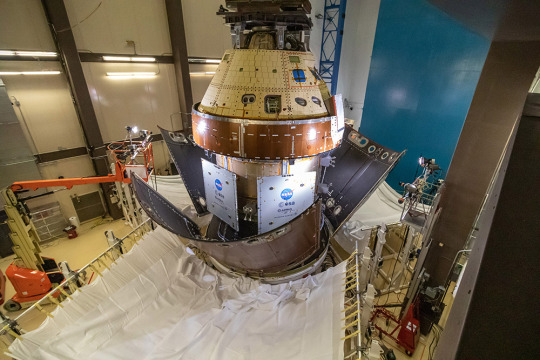
Before NASA astronauts fly Orion on missions to the Moon and back, testing is necessary to verify the spacecraft’s ability to withstand the stresses of launch, climb to orbit, the harsh conditions of deep space transit, and return to Earth. Engineers from NASA and its prime contractor, Lockheed Martin, completed testing on Orion’s Structural Test Article (STA) for Artemis I. The STA is structurally identical to Orion’s main spacecraft elements: the crew module, service module and launch abort system.
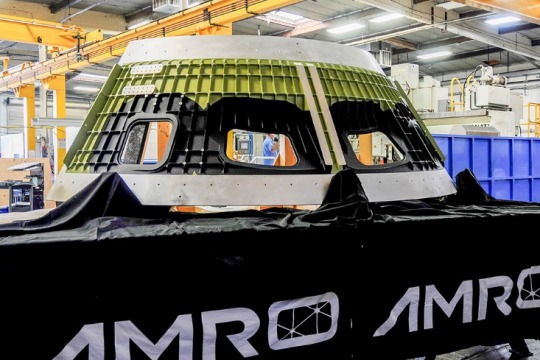
The first element machined for the Artemis III Orion crew module – a cone panel with openings for windows, which will provide a spectacular view – was designed by Lockheed Martin, and manufactured by AMRO Fabricating Corp., of South El Monte, California. The completed panel made its way to NASA’s Michoud Assembly Facility near New Orleans, where engineers will weld it with other elements as part of Orion’s pressure vessel.

Orion’s European Service Module primary structure for the Artemis III mission arrived at the Airbus facility in Bremen, Germany, from its Thales Alenia Space manufacturing site in Turin, Italy. The service module will be equipped with components to power Orion and provide life support to astronauts – such as air, water, heat and cooling -- during the mission that will land the first woman and next man on the Moon.

Three spacecraft adapter jettison fairing panels were fitted onto Orion’s service module inside the Neil Armstrong Operations and Checkout Building at Kennedy. Once secured, the panels encapsulate the service module to protect it from harsh environments such as heat, wind, and acoustics as the spacecraft is propelled out of Earth’s atmosphere atop the SLS rocket during NASA’s Artemis I mission.
768 notes
·
View notes
Photo


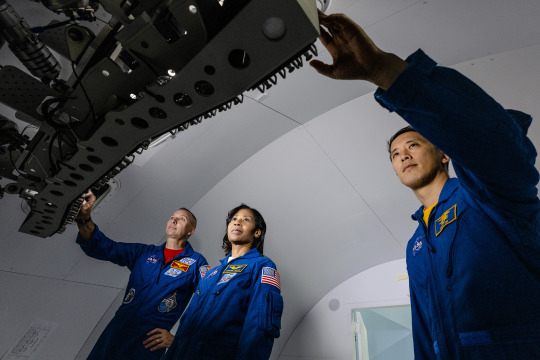


Orion's Mission Simulator, which will train Astronauts for #Artemis missions to the Moon, arrives at Johnson Space Center. https://www.nasa.gov/image-feature/orion-simulator-for-training-arrives-to-johnson
65 notes
·
View notes
Photo

Next year, researchers at NASA's Langley Research Center will test Orion's structural test article in a series water impact tests. The tests will prepare the final computer modeling for loads and structures prior to NASA's first mission that will carry members of the #Artemis Team around the Moon. http://go.nasa.gov/2Wrn5PJ
55 notes
·
View notes
Photo



Three spacecraft adapter jettison fairing panels have now been fitted onto Orion’s European Service Module as production accelerates inside the Neil Armstrong Operations and Checkout Building at NASA’s Kennedy Space Center in Florida. The panels were inspected and moved into place for installation by technicians with Lockheed Martin, the lead contractor for Orion. Once secured, they encapsulate the service module to protect it from harsh environments such as heat, wind, and acoustics as the spacecraft is propelled out of Earth’s atmosphere atop the Space Launch System (SLS) rocket during NASA’s Artemis I mission.
https://www.nasa.gov/feature/orion-is-fairing-well-and-moving-ahead-toward-artemis-i
32 notes
·
View notes



